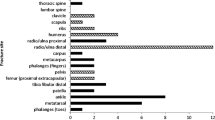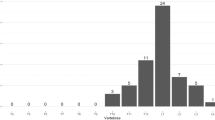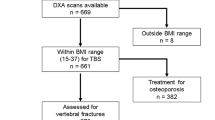Abstract
We evaluated the ability of bone density and vertebral fractures at baseline to predict vertebral fracture incidence in a cohort of postmenopausal women with osteoporosis. The study population was 380 postmenopausal women (mean age 65 years) treated for osteoporosis in a randomized, placebo-controlled, clinical trial of the bisphosphonate etidronate at seven geographic centers in the United States. Baseline measurements of bone mineral density were obtained in 1986 by quantitative computed tomography at the spine and dual-photon absorptiometry at the lumbar spine and hip. Vertebral fractures were documented on serial spine radiographs. Proportional hazards models were used to evaluate the ability to predict the risk of subsequent fractures during an average of 2.9 years of follow-up. Presence of one or two fractures increased the rate of new vertebral fractures 7.4-fold (95% confidence interval = 1.0 to 55.9). Additional fractures at baseline further increased the fracture rate. A decrease of 2 standard deviations in spinal bone density by absorptiometry was associated with a 5.8-fold increase in fracture rate (95% confidence interval = 2.9 to 11.6). The lowest and highest quintiles of bone density had absolute fracture rates of 120 and 6 cases per 1000 patient-years, respectively. In general, the simultaneous use of two predictors (bone density and prevalent fractures or two bone density measurements) improved fracture prediction, compared with the use of a single predictor. We conclude that both bone density and prevalent vertebral fractures are strong, complementary predictors of vertebral fracture risk. The results suggest that physicians can use bone density and prevalent vertebral fractures, individually or in combination, as risk factors to identify patients at greatest risk of new fractures.
Similar content being viewed by others
References
Wasnich RD, Ross PD, Maclean CJ, Vogel JM, Davis JW. A comparison of single versus multi-site BMC measurements for assessment of spine fracture probability. J Nuclear Med 1989;30:116–71.
Ross PD, Davis JW, Vogel JM, Wasnich RD. A critical review of bone mass and the risk of fractures in osteoporosis. Calcif Tiss Int 1990;46:149–61.
Ross PD, Davis JW, Epstein R, Wasnich RD. Pre-existing fractures and bone mass predict vertebral fracture incidence. Ann Intern Med 1991;114:919–23.
Black DM, Cummings SR, Genant HK, et al. Axial bone mineral density predicts fractures in older women [abstract]. J Bone Miner Res 1991;6(Suppl 1):S300.
Seeley DG, Browner WS, Nevitt MC, Genant HK, Scott JC, Cummings SR. Which fractures are associated with low appendicular bone mass in elderly women? Ann Intern Med 1991;115:837–42.
Wasnich RD, Ross PD, MacLean CJ, Davis JW, Vogel JM. The relative strengths of osteoporotic risk factors in a prospective study of postmenopausal osteoporosis. In: Christiansen C, Johansen JS, Riis BJ, editors. Osteoporosis 1987. Copenhagen: Osteopress, 1987:394–5.
Slemenda CW, Hui SL, Longcope C, Wellman H, Johnston CC Jr. Predictors of bone mass in perimenopausal women: a prospective study of clinical data using photon absorptiometry. Ann Intern Med 1990;112:96–101.
Melton LJ III, Ilstrup DM, Beckenbaugh RD, Riggs BL. Hip fracture recurrence: a population-based study. Clin Orthop 1982;167:131–8.
Gardsell P, Johnell O, Nilsson BE, Nilsson JA. The predictive value of fracture, disease and falling tendency for fragility fractures in women. Calcif Tissue Res 1989;45:327–30.
Murray TM, Harrison JE, Bayley TA, et al. Fluoride treatment of postmenopausal osteoporosis: age, renal function, and other clinical factors in the osteogenic response. J Bone Miner Res 1990;5(Suppl 1):S5-S26.
Watts NB, Harris ST, Genant HK, et al. Treatment of postmenopausal osteoporosis with cyclical etidronate with and without phosphate: a multicenter trial. N Engl J Med 1990;323:73–9.
Genant HK, Wu CY, Spencer NT, Black DM, Cummings SR. Vertebral fracture assessment using semiquantitative and quantitative techniques. J Bone Miner Res 1991;6(Supple 1):S274.
Genant H, Cann C, Ettinger B, Gordan G. Quantitative computed tomography of vertebral spongiosa: a sensitive method of detecting early bone loss after oophorectomy. Ann Intern Med 1982;97:699–705.
Mazess RB, Barden HS, Ettinger M, et al. Spine and femur density using dual-photon absorptiometry in US white women. Bone Miner 1987;2:211–19.
Ross PD, Wasnich RD, Vogel JM. Detection of pre-fracture spinal osteoporosis using bone mineral absorptiometry. J Bone Miner Res 1988;3:1–11.
Melton LJ III, Kan SH, Frye MA, Wahner HW, O'Fallon WM, Riggs BL. Epidemiology of vertebral fractures in women. Am J Epidemiol 1989;129:1000–11.
Black D, Cummings SR, Stone K, Hudes E, Palermo L, Steiger P. A new approach to defining normal vertebral dimensions. J Bone Miner Res 1991;6:883–91.
Steiger P, Block J, Steiger S, Heuck A, Friedlander A, Ettinger B, et al. Spinal bone mineral density measured with quantitative CT: effect of region of interest, vertebral level, and technique. Radiology 1990;175:537–43.
Nottestad SY, Baumel JJ, Kimmel DB, Recker RR, Heaney RP. The proportion of trabecular bone in human vertebrae. J Bone Miner Res 1987;2:221–9.
Eastell R, Mosekilde L, Hodgson SF, Riggs BL. Proportion of human vertebral body bone that is cancellous. J Bone Miner Res 1990;5:1237–41.
Cooper C, Atkinson EJ, O'Fallon WM, Melton LJ III. Incidence of clinically diagnosed vertebral fractures: a population-based study in Rochester, Minnesota, 1985–1989. J Bone Miner Res 1992;7:221–7.
Author information
Authors and Affiliations
Rights and permissions
About this article
Cite this article
Ross, P.D., Genant, H.K., Davis, J.W. et al. Predicting vertebral fracture incidence from prevalent fractures and bone density among non-black, osteoporotic women. Osteoporosis Int 3, 120–126 (1993). https://doi.org/10.1007/BF01623272
Received:
Accepted:
Issue Date:
DOI: https://doi.org/10.1007/BF01623272




